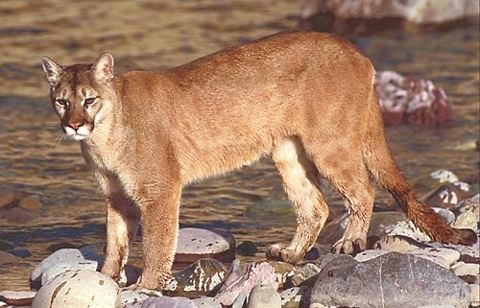Posts Tagged: mountain lion
Drought is a scapegoat for wildlife in urban areas
The story said a bear recently wandered into a Little League baseball game in San Luis Obispo and mountain lions are jumping fences in Northern California to kill goats. Experts said the sightings might be unusual, but not abnormal.
For decades, the article said, sprawling development into natural habitats has brought wild animals face to face with humans.
“In many cases, resources along the edge of the suburbs are far more reliable than resources out in the wild, because every year people are going to irrigate their fruit trees. Every year they're going to irrigate their lawns,” said Tom Scott, University of California Cooperative Extension specialist. “Animals are quick to use resources that are available.”
Scott said the drought is taking a toll on wildlife reproduction.
“This is the third year of drought, and that's three bad years of reproduction for wildlife species,” he said. “Wildlife population is starting to decline. It's attrition rather than a catastrophic drop, but if we went through another drought year, who knows?”
Incredible journey comes to unfortunate end
A mountain lion tracked with a GPS collar by UC Davis scientists made a two-month, 100-mile trek through San Diego County - skirting highways, the Wild Animal Park and Camp Pendleton beaches - before being shot in April because he raided a farm near the community of Japatul.
The San Diego Union Tribune reported last Saturday on the improbable journey of M56, the moniker by which the lion was known.
The UC Davis Wildlife Health Center began the mountain lion tracking project in 2000, the article said. At first, scientists focused on evaluating the impact of lions on federally protected bighorn sheep in Riverside and San Diego counties. Over time, they also assessed human-lion interactions and patterns of movement.
In 10 years, the scientists have collared 53 lions. Twenty-five of those have died from disease, collisions with cars, unlawful hunting and state-approved killings to remove animals deemed a nuisance.
UC Davis veterinarian Winston Vickers told reporter Mike Lee that about 20 adult lions now live in the Santa Ana Mountains, which are almost entirely separated from other habitat by freeways and homes.
The odyssey of M56 surprised scientists.
"We didn’t even have any idea that a mountain lion could travel that far in this fragmented landscape so quickly,” the story quoted Trish Smith, a senior ecologist for The Nature Conservancy in San Diego.
Ultimately, M56 found a farm with six or eight sheep and at least one sheep was killed. If the owner of a deceased domestic animal requests its killer be put down, officials are obligated to do so.
However, in its short life - estimated to be between 18 and 20 months long - M56 did its part for mountain lion conservation. The story said scientists will continue to reference M56's incredible journey for years as they study how people and lions can co-exist.
Read more about mountain lions in California on the Southern California Ecosystem Health Program website.

Mountain lion (Photo: Wikimedia Commons)


